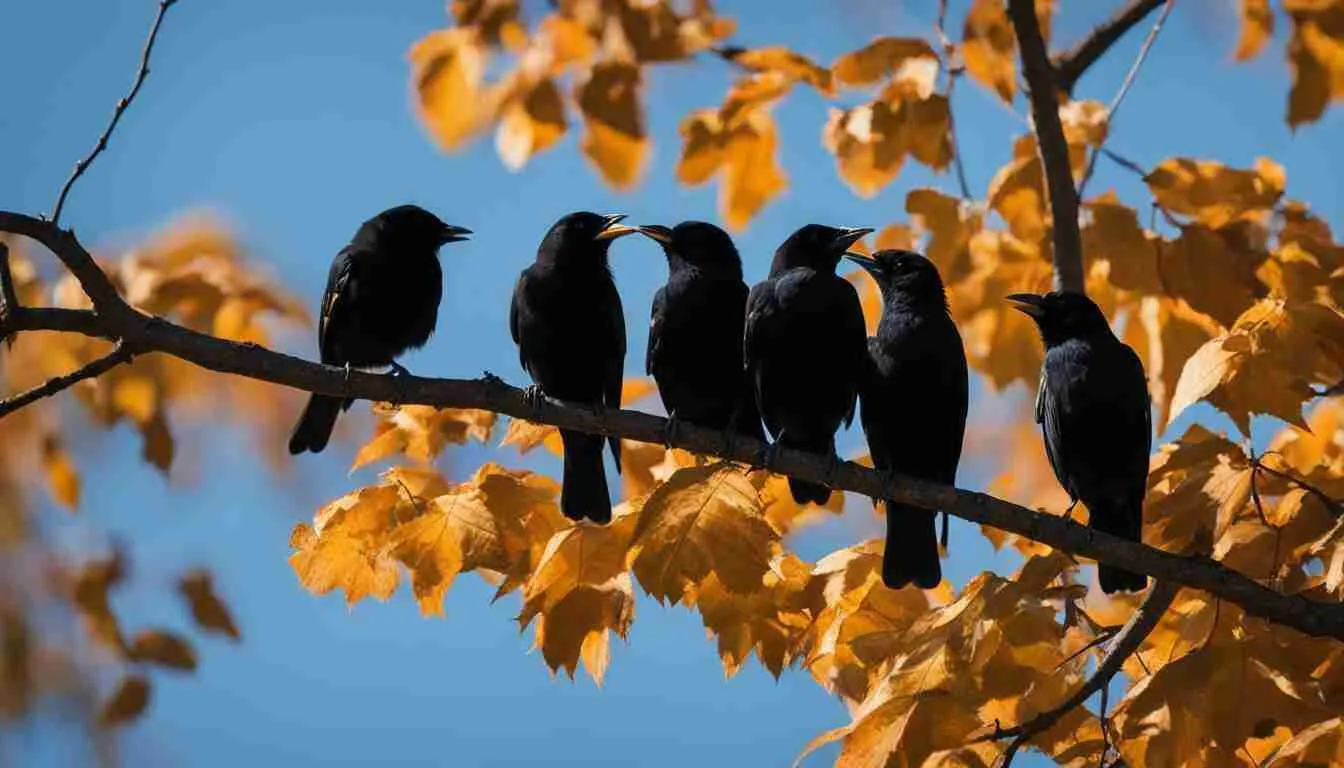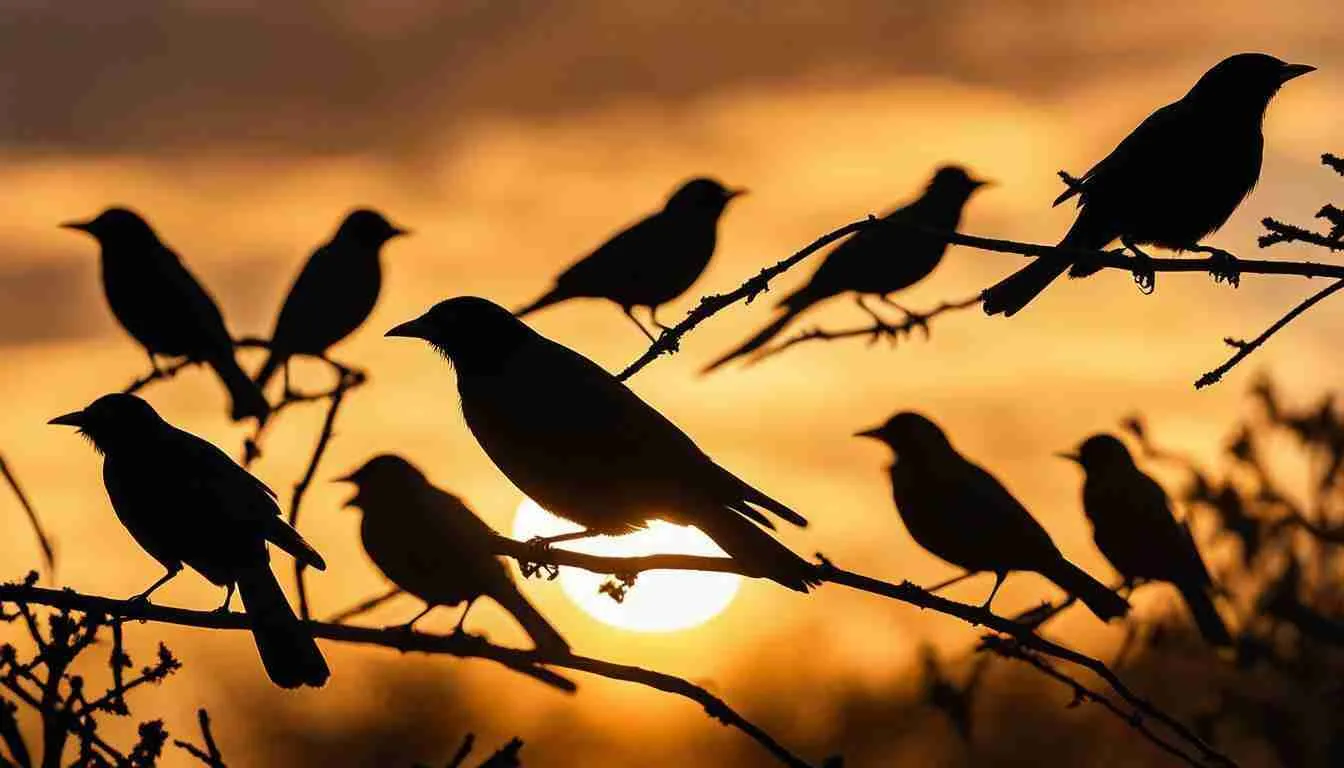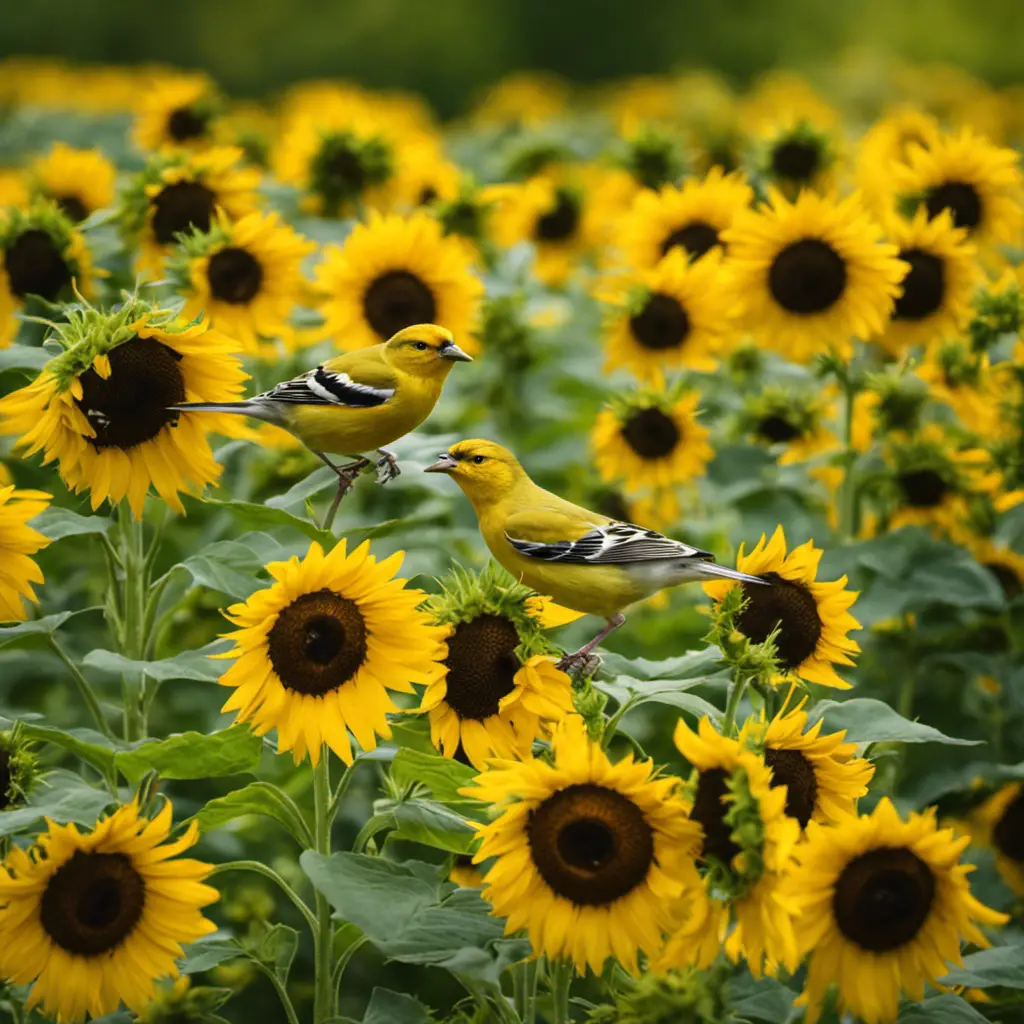Michigan is home to a diverse range of black birds, making it a popular destination for birdwatchers. The state’s varied habitats and ecosystems provide a haven for many different bird species, including a wide variety of black birds. These captivating creatures showcase a range of unique characteristics, from their appearance to their behaviors.
- Red-winged Blackbirds and Common Grackles are the most frequently spotted blackbirds in Michigan during the summer.
- European Starlings are year-round residents in Michigan.
- The Rusty Blackbird is a migratory species that passes through Michigan in large flocks.
- Bobolinks are becoming increasingly rare but can still be found in large fallow fields.
- Brewer’s Blackbirds are often found in human-altered environments and gather in large flocks in autumn.
These are just a few examples of the black bird species that can be found in Michigan. Each one offers a unique opportunity for birdwatchers to observe and appreciate the wonders of nature. Whether you’re an experienced birder or just starting out, exploring the diverse black bird species in Michigan is sure to provide a rewarding and memorable experience.
Red-winged Blackbird
The Red-winged Blackbird is a common sight in Michigan, known for its striking appearance and distinctive call. With its black feathers and vibrant red shoulder patches, it is easily recognizable and stands out among other bird species. Male Red-winged Blackbirds are larger than females and have a melodic song that echoes throughout wetlands and marshes. These birds are highly territorial during the breeding season and can be seen perched atop cattails and other tall vegetation, defending their nesting sites.
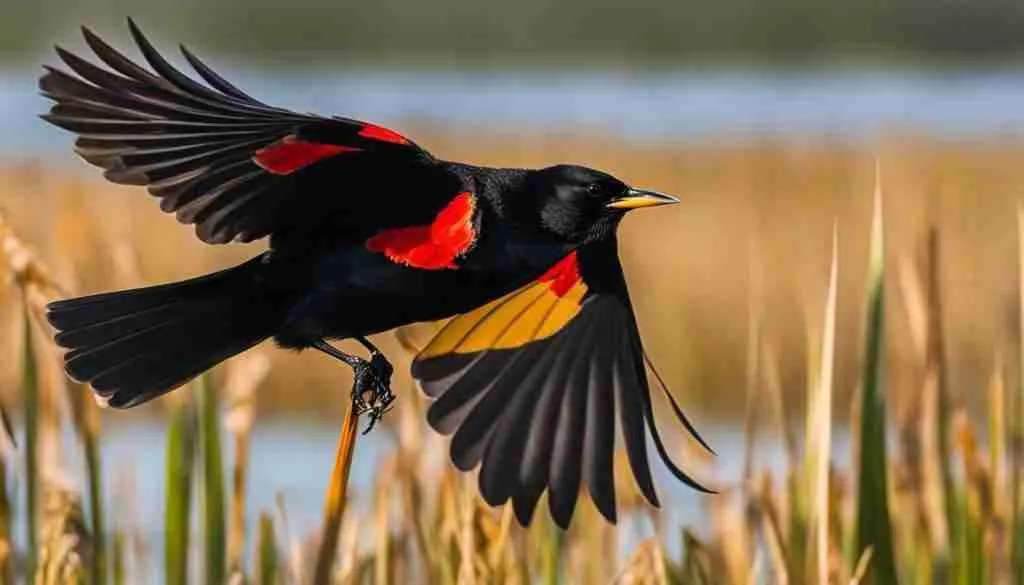
Characteristics and Behavior
The male Red-winged Blackbird is characterized by its black plumage and red shoulder patches, which it displays during territorial displays.
Red-winged Blackbirds primarily feed on insects, seeds, and grains. They are omnivorous and will also eat fruits and berries when available. During the winter months, they form large flocks and forage in fields and agricultural areas. These birds are skilled flyers and can often be seen in acrobatic flight, darting through the air with ease.
Habitat and Distribution
Red-winged Blackbirds can be found throughout Michigan, particularly in wetland areas such as marshes, swamps, and bogs. They are adaptable birds and can also be seen in agricultural fields, meadows, and roadside ditches. These birds are common across North America, with populations found from Alaska to Florida.
Birdwatching Tips
- Look for male Red-winged Blackbirds perched on cattails or other tall vegetation, displaying their red shoulder patches.
- Listen for their distinctive song, a series of musical notes followed by a throaty gurgle.
- Visit wetland areas and agricultural fields during the breeding season for the best chance of spotting these birds.
| Common Name | Scientific Name | Conservation Status |
|---|---|---|
| Red-winged Blackbird | Agelaius phoeniceus | Least Concern |
Common Grackle
With its glossy black plumage and piercing yellow eyes, the Common Grackle is a frequent visitor to Michigan’s parks and gardens. This medium-sized blackbird is known for its distinctively long tail and iridescent feathers that shine with hues of blue, green, and purple in the sunlight. Common Grackles are highly adaptable and can be found in a variety of habitats, including woodlands, wetlands, and suburban areas.
These birds are opportunistic omnivores, feeding on a wide range of food sources. They have a diverse diet that includes insects, fruits, grains, and even small mammals. Common Grackles are known for their foraging behavior, often seen probing the ground with their strong bills or searching for food in cracks and crevices.
During the breeding season, male Common Grackles are known for their distinctive calls, which sound like a mix of rusty gate hinges and high-pitched squeaks. They build their nests in trees, usually near water, constructing a sturdy cup-shaped structure made of grass, twigs, and other plant materials. Females lay 3-7 pale blue or greenish eggs, which hatch after an incubation period of approximately two weeks.
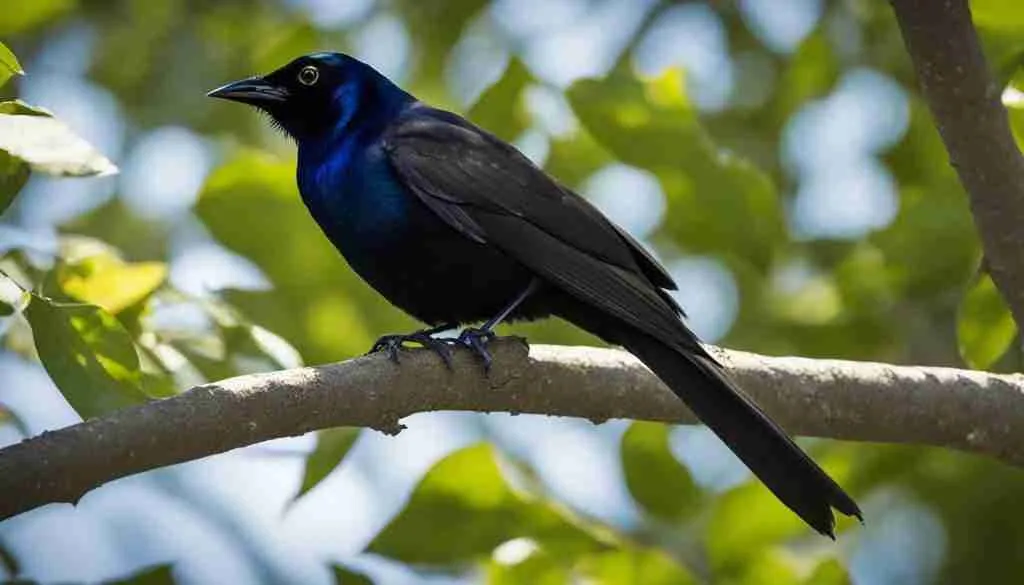
“Common Grackles are social birds and often gather in large flocks, especially during the winter months. These flocks can sometimes number in the thousands and create a spectacular sight in the sky.”
Key Features:
- Glossy black plumage
- Piercing yellow eyes
- Long, keel-shaped tail
- Iridescent feathers with blue, green, and purple hues
| Scientific Name | Quiscalus quiscula |
|---|---|
| Size | Approximately 12-13 inches |
| Habitat | Woodlands, wetlands, and suburban areas |
| Diet | Insects, fruits, grains, and small mammals |
| Call | Distinctive mix of rusty gate hinges and high-pitched squeaks |
European Starling
The European Starling, with its iridescent feathers and melodious songs, can be spotted throughout Michigan in all seasons. These charismatic black birds are known for their stunning plumage, which shimmers with shades of purple and green. Their ability to mimic other bird calls adds to their allure, making them a joy to watch and listen to.
This adaptable species has thrived in North America since its introduction in the late 1800s. European Starlings are highly social, often seen in large flocks that create impressive aerial displays known as murmurations. These birds are opportunistic feeders, consuming a wide range of food including insects, fruits, and seeds. They are commonly found in a variety of habitats, from urban areas to suburban neighborhoods, parks, and farmland.
“The European Starling is a truly remarkable bird, both visually and acoustically. Its striking appearance and ability to mimic other species make it a delightful addition to Michigan’s birdwatching scene.”
When observing European Starlings, it’s worth noting their nesting habits. They often nest in tree cavities, crevices, or man-made structures such as buildings and birdhouses. Their nests are constructed with twigs, grass, and feathers, providing a cozy home for their young. During breeding season, males display their courtship plumage, adorned with speckled spots, in an effort to attract mates.
To attract European Starlings to your backyard, consider providing mixed grains and seeds spread on the ground or using feeders. These birds enjoy foraging for food on the ground and will readily visit feeders if the food is easily accessible. Creating a welcoming habitat with shrubs and trees can also encourage them to visit and potentially nest in your yard.
European Starling Facts:
- Scientific Name: Sturnus vulgaris
- Length: 7-9 inches
- Weight: 2-3 ounces
- Wingspan: 12-15 inches
- Diet: Insects, fruits, seeds, grains
- Habitat: Urban areas, suburban neighborhoods, farmland
- Range: Throughout Michigan
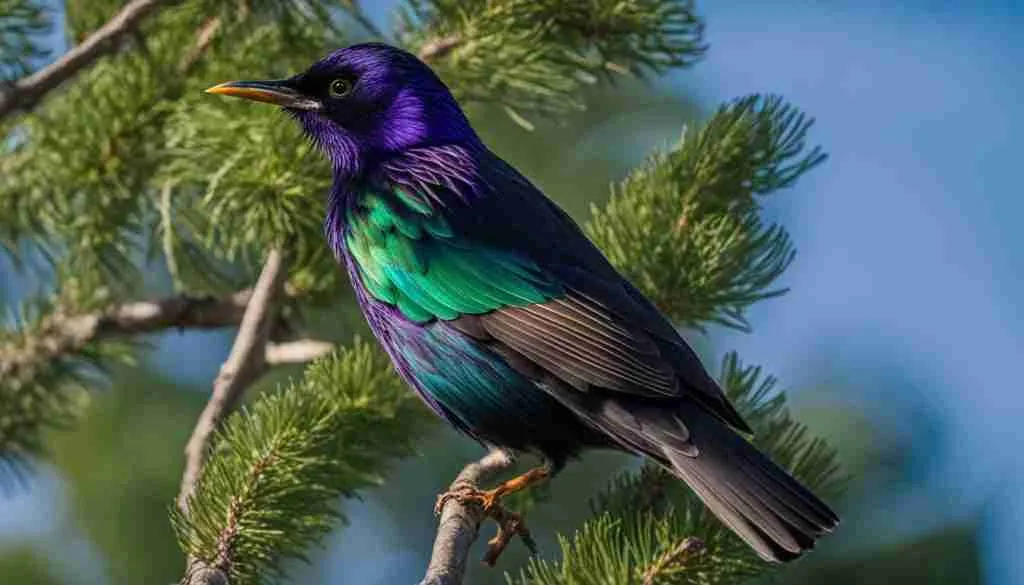
| Characteristics | Habitat | Nesting |
|---|---|---|
| Adaptable and sociable | Urban areas, suburban neighborhoods, parks, farmland | Tree cavities, man-made structures |
| Iridescent plumage | Twigs, grass, feathers | |
| Mimicry of other bird calls |
Rusty Blackbird
During the migration season, Michigan becomes a temporary home for the Rusty Blackbird, a rare and captivating species. Known for its stunning rusty brown plumage and yellow eyes, this black bird adds a touch of color to the state’s diverse bird population. Rusty Blackbirds can be found in wetland areas, particularly swamps, marshes, and flooded woodlands, where they forage for insects, fruits, and seeds.
These migratory birds travel long distances, with their wintering grounds stretching from the southern United States to Central America. Michigan serves as an important stopover point during their journey. Here, they gather in large flocks, providing birdwatchers with a remarkable sight and an opportunity to observe their behavior and listen to their unique calls.
“The Rusty Blackbird is a true wonder to behold. Its striking plumage and melodic calls make it a true gem for birdwatchers in Michigan,” said Jane Wilson, an avid bird enthusiast.
To attract Rusty Blackbirds to your backyard, consider providing a water source such as a bird bath or small pond, as they are particularly drawn to areas with standing water. Planting native shrubs and trees can also create an inviting habitat for them, as it provides nesting sites and food sources.
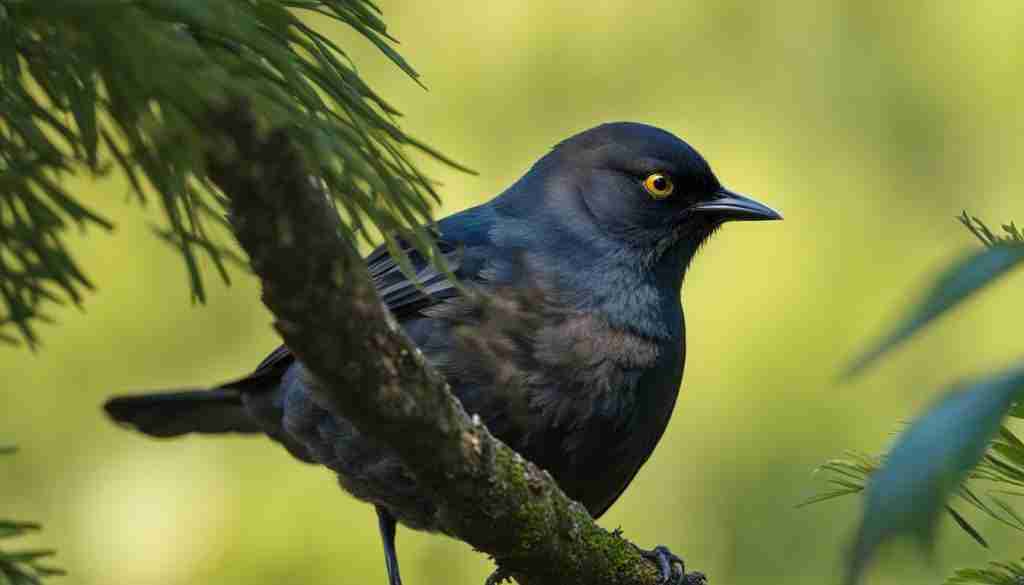
| Name | Scientific Name | Habitat |
|---|---|---|
| Rusty Blackbird | Euphagus carolinus | Wetlands, swamps, marshes, flooded woodlands |
The Rusty Blackbird is just one of the many fascinating black bird species found in Michigan. Whether you’re an experienced birdwatcher or a novice enthusiast, exploring the diverse avian population in the state provides a unique opportunity to appreciate nature’s beauty and the wonder of these captivating creatures.
Bobolink: A Rare Gem in Michigan’s Fallow Fields
The Bobolink, with its unique song and distinctive plumage, can still be found in select fallow fields throughout Michigan. This striking black bird, also known as the “rice bird” or “skunk blackbird,” is a sight to behold. The male Bobolink boasts a black body with white patches on its back, while the female exhibits a more subdued appearance.
During the breeding season, Bobolinks can be heard serenading the fields with their bubbling, tinkling songs. Their vocal prowess has earned them the nickname “butterfly of the meadow.” This enchanting display, paired with their striking appearance, makes them a true gem for birdwatching enthusiasts.
To catch a glimpse of these elusive birds, it’s best to explore large fallow fields, where they prefer to nest and feed. Bobolinks are becoming rarer due to habitat loss, so spotting them is a special treat. Their conservation status adds to their allure, making them a must-see for any birdwatcher visiting Michigan.
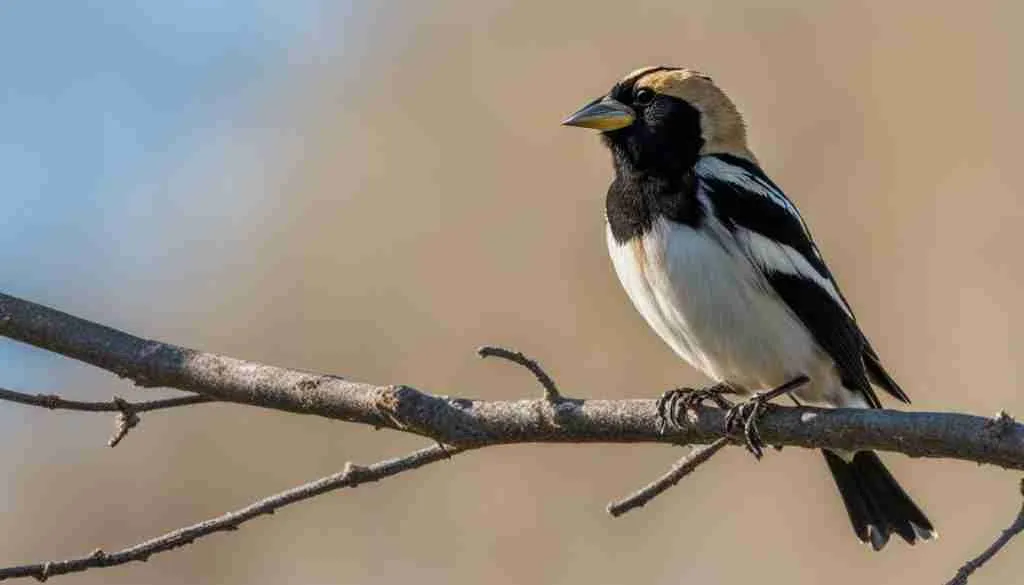
As you embark on your birdwatching journey in Michigan, keep your eyes and ears open for the Bobolink’s distinctive call. With fields as their stage, these beautiful black birds captivate the hearts of all who encounter them. Make sure to bring your binoculars and a sense of wonder, as you never know what other avian wonders await you in the state’s diverse habitats.
Table: Rare Black Birds in Michigan
| Black Bird Species | Distinctive Characteristics | Habitat Preferences |
|---|---|---|
| Bobolink | Black body with white patches, unique bubbling song | Fallow fields |
| Blackbird | Glossy black plumage, melodious songs | Open woodlands, fields, and wetlands |
| Common Grackle | Iridescent plumage, piercing yellow eyes | Urban areas, agricultural fields |
| Rusty Blackbird | Dusky black plumage with rusty edges | Wet woodlands, marshes |
“The Bobolink’s unique song and captivating appearance make it a treasured find in Michigan’s fallow fields.”
Keep in mind that bird populations can vary, and sightings may not be guaranteed. It’s always essential to respect the birds’ habitats and observe them from a safe and appropriate distance. Happy birdwatching!
Brewer’s Blackbird
In the autumn months, Michigan’s urban areas come alive with the sights and sounds of the Brewer’s Blackbird, a gregarious and adaptable species. These blackbirds, with their glossy feathers and bright yellow eyes, can be spotted perched on power lines or foraging in open fields. They are opportunistic feeders, consuming a wide range of food including insects, grains, and berries.
Known for their flocking behavior, Brewer’s Blackbirds can gather in massive numbers, creating breathtaking displays as they take to the skies. They are highly social birds, often seen congregating with other blackbird species, such as Red-winged Blackbirds and Common Grackles. This collective behavior provides them with safety in numbers and increased foraging efficiency.
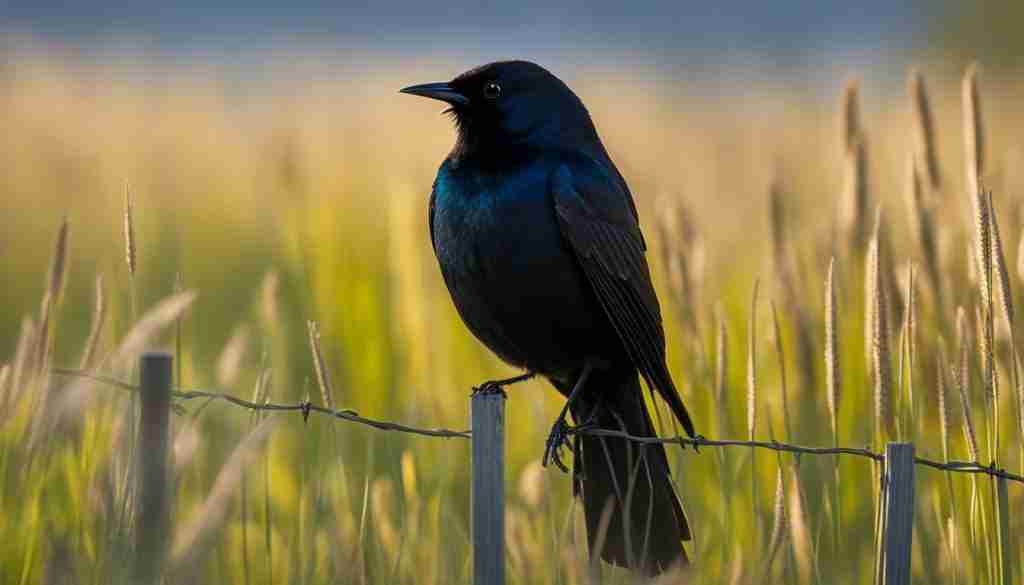
Brewer’s Blackbirds are adaptable to various habitats, making them a common sight across Michigan. They can be found in both rural and urban environments, including parks, farmlands, and suburban areas. During the autumn months, they gather in large flocks, creating a spectacle for birdwatchers and nature enthusiasts.
Habitat Preferences:
| Habitat Type | Preferred Locations |
|---|---|
| Open Fields | Rural and suburban areas, farmlands |
| Urban Areas | Parks, parking lots, city streets |
| Wetlands | Marshes, lakeshores |
When observing Brewer’s Blackbirds, it’s fascinating to witness their social interactions and communication. They often engage in vocal displays, using a variety of calls and songs to communicate with one another. Their melodic whistling and chattering create a beautiful symphony that echoes across their chosen habitats.
If you’re planning a birdwatching expedition in Michigan, keep an eye out for the Brewer’s Blackbird. Their adaptability and sociable nature make them a captivating species to observe, especially during the autumn months when they thrive in the state’s urban landscapes.
The Brown-headed Cowbird: A Fascinating but Controversial Black Bird Species in Michigan
The Brown-headed Cowbird, with its parasitic nesting habits and striking appearance, is a fascinating but controversial black bird species in Michigan. Known for laying their eggs in the nests of other bird species, Brown-headed Cowbirds have a unique reproductive strategy. While this behavior allows them to save energy and allocate resources elsewhere, it also raises concerns about the impact on other bird populations.
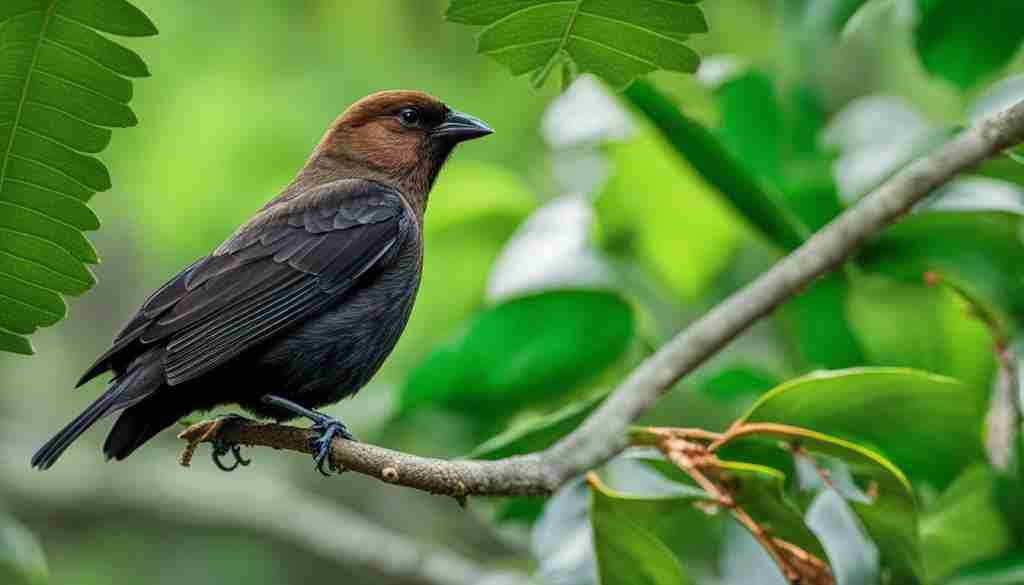
The Brown-headed Cowbird is easily recognizable with its glossy black plumage and a distinctive brown head that contrasts sharply against its dark body. This species can be found throughout the state of Michigan, occupying a wide range of habitats such as woodlands, grasslands, and even suburban areas. They are opportunistic feeders, consuming a diverse diet that includes insects, seeds, and grains.
Due to its parasitic behavior, the Brown-headed Cowbird has faced controversy and criticism. Their habit of laying eggs in the nests of other bird species, often resulting in the abandonment of the host’s eggs, can have detrimental effects on the reproductive success of the host birds. However, some bird species have adapted to coexist with cowbirds by recognizing and rejecting cowbird eggs from their nests.
Table 1: Black Bird Species in Michigan
| Species | Characteristics | Habitat |
|---|---|---|
| Red-winged Blackbird | Distinctive red and yellow shoulder patches | Marshes, wetlands, and open fields |
| Common Grackle | Iridescent black feathers and yellow eyes | Urban areas, farmlands, and woodlands |
| European Starling | Speckled plumage and mimicry of other bird songs | Various habitats including urban areas |
| Rusty Blackbird | Dull black plumage with rusty edges | Wetlands, floodplains, and forested areas |
In conclusion, the Brown-headed Cowbird is a captivating black bird species found in Michigan that evokes both fascination and controversy. Its unique reproductive strategy and striking appearance make it an intriguing subject for birdwatchers and researchers alike. By understanding and studying the behavior and ecological interactions of the Brown-headed Cowbird, we can uncover valuable insights into the delicate balance of nature in Michigan.
Orioles and Meadowlarks
Michigan’s forests and meadows are home to a variety of orioles and meadowlarks, each with its own unique beauty and presence. Among these black bird species, the Orchard Oriole, Baltimore Oriole, Hooded Oriole, Western Meadowlark, and Yellow-headed Blackbird are frequently seen in the state.
The Orchard Oriole, with its vibrant orange plumage and melodious song, is a small black bird that can be found in wooded areas and orchards. It is known for its beautiful woven nests and its preference for insects and nectar as its primary food sources. Birdwatchers can spot this stunning species during the breeding season, from May to August, when they engage in their intricate courtship displays.
The Baltimore Oriole, named after Lord Baltimore’s colors, showcases a striking orange and black plumage that is sure to catch the eye of any observer. These birds prefer open woodlands and can often be found nesting in maple, oak, and elm trees. Known for their unique hanging nests, Baltimore Orioles feed on insects, fruits, and nectar. Their bright colors and sweet songs make them a delight to encounter during the summer months.
| Orchard Oriole | Baltimore Oriole |
|---|---|
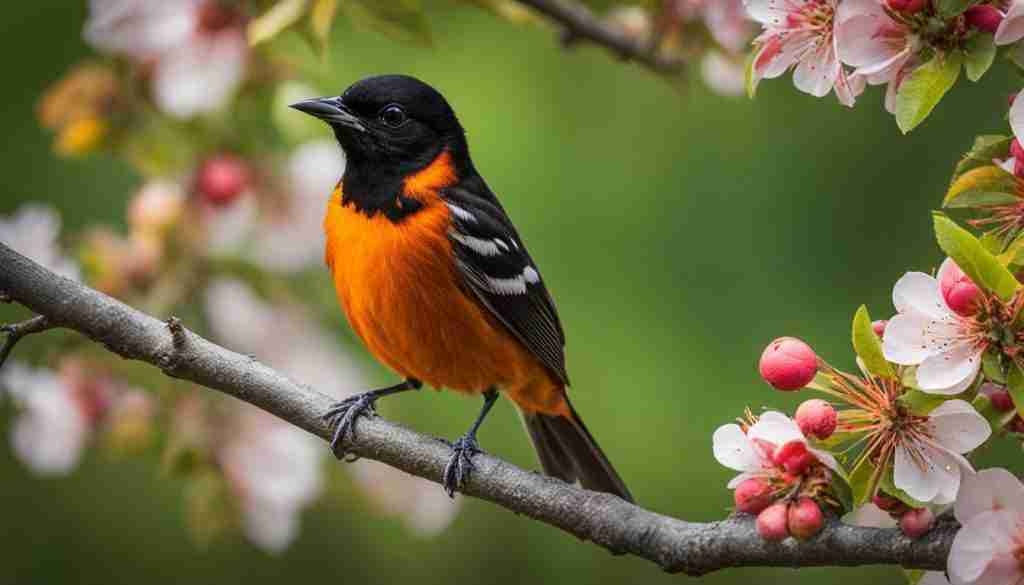 |  |
The Hooded Oriole, similar in appearance to the Baltimore Oriole, sports a vibrant yellow hood with black wings and back. These orioles prefer palm trees and can be found in Michigan’s southern regions during their breeding season. With their melodious songs and graceful flight, Hooded Orioles bring a touch of tropical beauty to the state.
The Western Meadowlark, although not strictly a black bird, possesses a black V-shaped bib on its chest. These birds inhabit grasslands and meadows, where their distinct flute-like songs can be heard. Western Meadowlarks are known for their ground-nesting behavior and feed on insects, seeds, and berries. Spotting their bright yellow chests and hearing their melodic calls is an enchanting experience in Michigan’s open landscapes.
Michigan’s orioles and meadowlarks add vibrant colors and melodious songs to the state’s birdlife. From the Orchard Oriole’s delicate beauty to the Baltimore Oriole’s impressive hanging nests, these black bird species captivate birdwatchers with their unique characteristics. The Hooded Oriole’s striking yellow hood and the Western Meadowlark’s beautiful song further enhance Michigan’s natural landscape. Observing these stunning birds in their natural habitats is a true delight for nature enthusiasts.
Shiny Cowbird
The Shiny Cowbird, with its iridescent plumage and unexpected appearances, is a surprising find for dedicated birdwatchers in Michigan. This species, native to South America, occasionally strays to the state, making it a rare sighting for enthusiasts. Standing out with its shiny black feathers and striking yellow eyes, the Shiny Cowbird adds a touch of exoticism to the local bird population.
Although it is an accidental and occasional visitor, sightings of the Shiny Cowbird have been reported in Michigan, particularly during migration seasons. The bird favors diverse open habitats such as grasslands, agricultural areas, and forest edges, where it can find suitable hosts for its parasitic nesting behavior. Female Shiny Cowbirds lay their eggs in the nests of other bird species, leaving the host parents to raise their young along with their own.
Distinctive Features
One of the key characteristics of the Shiny Cowbird is its glossy black plumage, which catches the sunlight and shines brilliantly. The male Shiny Cowbird is known for its robust and stocky build, with a slightly curved bill and dark eyes that contrast beautifully against its dark feathers. Its song is a complex and varied medley of notes, adding to its allure during the brief moments it graces Michigan with its presence.
| Distinctive Features | Behavior | Habitat |
|---|---|---|
| • Glossy black plumage | • Parasitic nesting behavior | • Open habitats such as grasslands, agricultural areas, and forest edges |
| • Striking yellow eyes | • Lays eggs in the nests of other bird species | |
| • Robust and stocky build |
Although the Shiny Cowbird’s appearances in Michigan may be fleeting, the opportunity to witness this unique bird in the northern reaches of its range is a remarkable experience. For birdwatchers in Michigan, keeping an eye out for this rare visitor can bring a sense of excitement and wonder to their birding adventures.
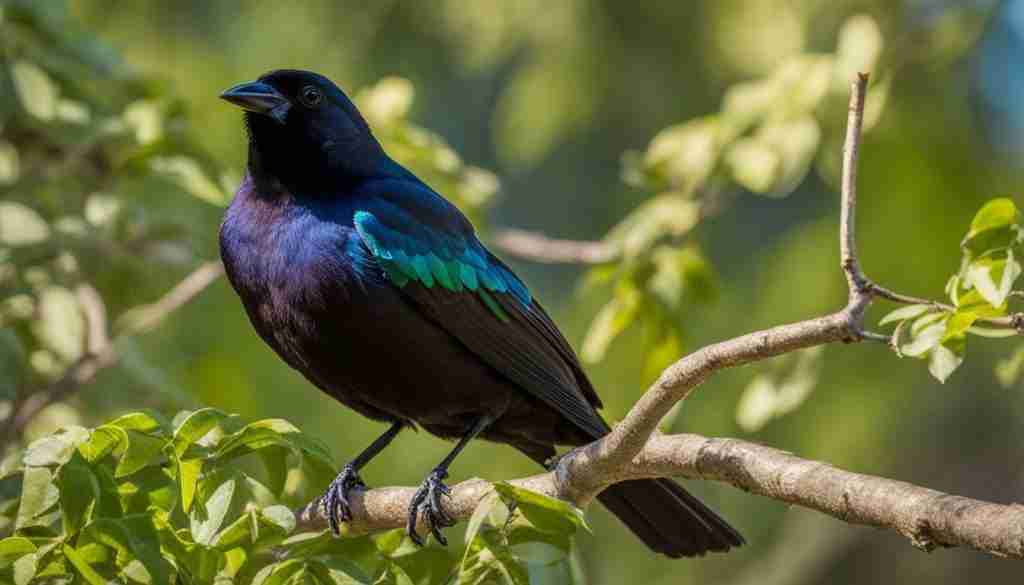
In the next section of this article, we will explore another migratory black bird species that passes through Michigan during its journey – the Eastern Meadowlark. Stay tuned for more fascinating insights into the diverse bird species found in Michigan.
Eastern Meadowlark
Michigan’s grasslands come alive with the captivating songs of the Eastern Meadowlark during their migratory periods. These beautiful black birds are known for their distinctive melodies, filling the air with cheerful notes that brighten up the landscape. With their vibrant yellow undersides and bold black markings on their backs, Eastern Meadowlarks are an exquisite sight to behold.
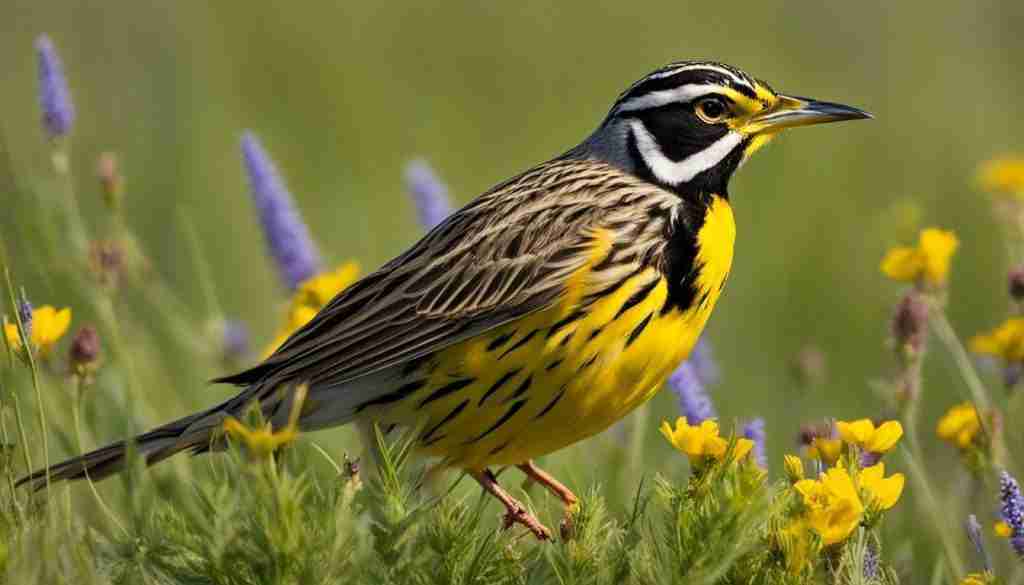
During the spring and fall, Eastern Meadowlarks pass through Michigan, making it an ideal time for birdwatchers to catch a glimpse of these enchanting creatures. These migratory birds prefer open grasslands, fields, and meadows with minimal tree cover, where they can forage for insects and seeds. Their melodious songs can carry over long distances, serving as territorial and courtship displays.
For avid birdwatchers, Michigan offers various locations to observe the Eastern Meadowlark in its natural habitat. Grasslands and prairies, such as Shiawassee National Wildlife Refuge and Kellogg Bird Sanctuary, are popular birdwatching spots where you can listen to their melodic songs and witness their graceful flight patterns.
“Michigan’s grasslands come alive with the captivating songs of the Eastern Meadowlark during their migratory periods.”
As the Eastern Meadowlark’s population faces challenges due to habitat loss and changes in land use, conservation efforts play a vital role in preserving these remarkable birds. By supporting organizations dedicated to habitat conservation and promoting sustainable land management practices, we can ensure their continued presence in Michigan’s vibrant ecosystem.
Eastern Meadowlark Facts
| Scientific Name | Sturnella magna |
|---|---|
| Size | Approximately 9-11 inches |
| Habitat | Grasslands, fields, and meadows |
| Diet | Insects, seeds, and berries |
| Conservation Status | Least Concern |
Other Black Birds in Michigan
Apart from the common black bird species in Michigan, there are a few rarer sightings that add excitement to the birdwatching experience. These black birds may not be as frequently seen, but spotting them can be a thrilling and rewarding event for birdwatching enthusiasts. Let’s explore some of these less common black bird species found in Michigan.
Eastern Towhee
The Eastern Towhee, also known as the Rufous-sided Towhee, is a black bird species that can be found in Michigan during the breeding season. With its striking black plumage and bright red eyes, the Eastern Towhee stands out in the birdwatching community. It prefers shrubby areas, wood edges, and fields, making it a unique sighting for those exploring Michigan’s diverse habitats.
Hooded Oriole and Western Meadowlark
The Hooded Oriole and Western Meadowlark are two black bird species recognized as rare but regularly occurring in Michigan. The Hooded Oriole, with its vibrant black and yellow plumage, is a treat for birdwatchers lucky enough to spot it. The Western Meadowlark, known for its beautiful melodic songs, adds a touch of enchantment to Michigan’s birdwatching spots. Keep an eye out for these exceptional black birds on your next birding adventure.
| Black Bird Species | Preferred Habitats | Notable Characteristics |
|---|---|---|
| Eastern Towhee | Shrubby areas, wood edges, fields | Striking black plumage, red eyes |
| Hooded Oriole | Woodlands, parks, gardens | Black and yellow plumage |
| Western Meadowlark | Prairies, grasslands, farmlands | Melodic songs, yellow underparts |
Spotting these rarer black bird species in Michigan brings a sense of wonder and discovery to birdwatching. Their unique characteristics, behaviors, and enchanting appearances make them a treasured find for both experienced and novice birders alike. As you explore Michigan’s birdwatching spots, keep your eyes and ears open for these captivating black birds, and don’t forget to bring your binoculars and camera to capture the magic of these extraordinary sightings.
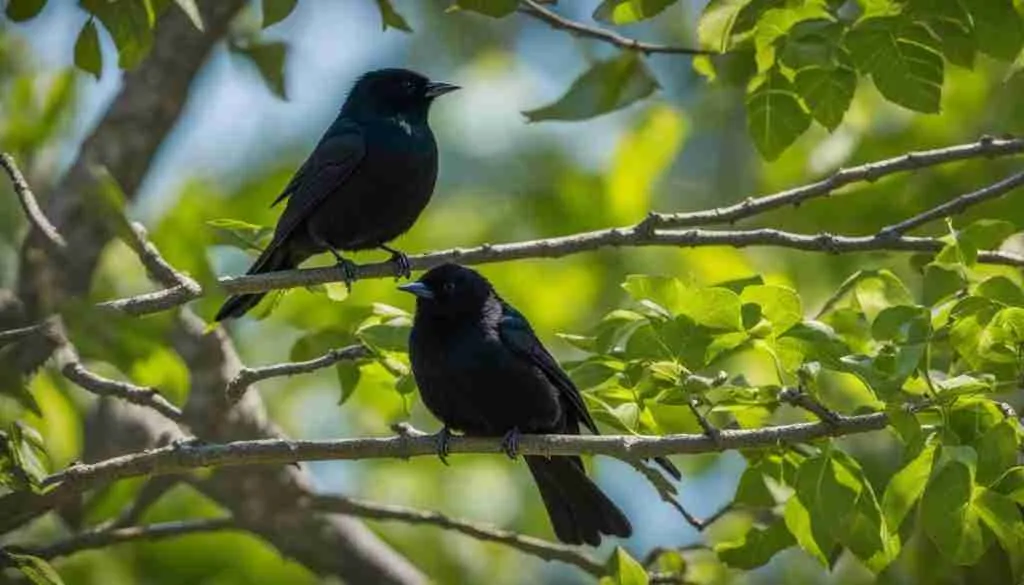
Attracting blackbirds to your backyard can be an enjoyable and rewarding endeavor. By providing mixed grains and seeds spread on the ground or using feeders specifically designed for these birds, you can create a welcoming environment for blackbirds to visit. Remember to maintain a clean feeding area and refill the feeders regularly to ensure the blackbirds keep coming back.
Michigan offers a diverse range of black bird species, each with its own fascinating characteristics and behaviors. From the common Red-winged Blackbird and European Starling to the rarer sightings of the Eastern Towhee, Hooded Oriole, and Western Meadowlark, there is always something new and exciting to discover in the world of black birds. So grab your binoculars, head out to Michigan’s birdwatching spots, and embark on a captivating journey through the diverse world of black birds.
Conclusion
Michigan’s black birds offer birdwatching enthusiasts a wonderful opportunity to discover the magic of nature in their own backyard. With a diverse range of species, each possessing unique characteristics and habitat preferences, the black birds of Michigan captivate both novice and experienced birdwatchers alike.
The Red-winged Blackbird and Common Grackle are the most frequently spotted blackbirds during the summer months, filling the air with their distinctive calls. European Starlings, on the other hand, are year-round residents, showcasing their iridescent plumage throughout the year.
For those seeking the awe-inspiring sight of massive flocks, the migratory Rusty Blackbird graces Michigan’s skies during its journey. Meanwhile, the elusive Bobolink, once common, has become increasingly rare, preferring large fallow fields. Brewer’s Blackbirds, on the other hand, are often found in human-altered environments, gathering in large flocks during autumn.
Other black bird species, such as the Brown-headed Cowbirds, Orioles, Meadowlarks, and Cowbirds, frequent Michigan, each adding their unique charm to the state’s avian population. Additionally, the rare appearances of the Shiny Cowbird and the migratory Eastern Meadowlark provide birdwatchers with exciting opportunities to spot these elusive species.
While not classified as blackbirds, some black-colored bird species like the Common Gallinule, American Coot, and American Crow also populate Michigan’s skies. To attract these captivating birds to your backyard, providing mixed grains and seeds on the ground or using feeders can prove fruitful.
Michigan’s black birds are a testament to the beauty of nature and the wonders that await those who venture into the world of birdwatching. From their varied sizes and colorations to their unique nesting behaviors and migratory patterns, blackbirds provide endless fascination for those who take the time to observe and appreciate them.
FAQ
Q: What are the 15 most common black birds in Michigan?
A: The 15 most common black birds in Michigan are the Red-winged Blackbird, Common Grackle, European Starling, Rusty Blackbird, Bobolink, Brewer’s Blackbird, Brown-headed Cowbird, Eastern Towhee, Orchard Oriole, Baltimore Oriole, Yellow-headed Blackbird, Shiny Cowbird, Eastern Meadowlark, Hooded Oriole, and Western Meadowlark.
Q: Which black birds are the most frequently spotted in Michigan during the summer?
A: The most frequently spotted black birds in Michigan during the summer are the Red-winged Blackbird and Common Grackle.
Q: Which black bird species are year-round residents in Michigan?
A: European Starlings are year-round residents in Michigan.
Q: Which black bird species pass through Michigan during migration?
A: The Rusty Blackbird is a migratory species that passes through Michigan in large flocks.
Q: Where can I find Bobolinks in Michigan?
A: Bobolinks are increasingly rare in Michigan but prefer large fallow fields.
Q: Where do I often find Brewer’s Blackbirds in Michigan?
A: Brewer’s Blackbirds are often found in human-altered environments in Michigan and gather in large flocks in autumn.
Q: What is unique about Brown-headed Cowbirds?
A: Brown-headed Cowbirds are known for laying their eggs in the nests of other bird species.
Q: What black bird species can I find in Michigan other than Red-winged Blackbirds and Grackles?
A: Other black bird species commonly seen in Michigan include Eastern Towhees, Orchard Orioles, Baltimore Orioles, Yellow-headed Blackbirds, Shiny Cowbirds, Eastern Meadowlarks, Hooded Orioles, and Western Meadowlarks.
Q: How can I attract blackbirds to my backyard?
A: You can attract blackbirds to your backyard by providing mixed grains and seeds spread on the ground or using feeders.
Q: Are there any other black-colored birds in Michigan that are not classified as blackbirds?
A: Yes, there are other black-colored birds in Michigan such as the Common Gallinule, American Coot, and American Crow, but they are not classified as blackbirds.
Q: What are the types of black birds found in Michigan?
A: There are several types of black birds that can be found in Michigan. Some of these include the red-winged blackbird, common grackle, Brewer’s blackbird, brown-headed cowbird, and shiny cowbird.
Q: Where can black birds be found in Michigan?
A: Black birds can be found throughout Michigan, including in both northern and southern regions of the state.
Q: Do black birds prefer open water habitats?
A: Yes, some black bird species, such as the Brewer’s blackbird and shiny cowbird, are known to prefer habitats near open water.
Q: What are some distinguishing features of black birds in Michigan?
A: Black birds in Michigan often have black bodies with various markings, such as white patches or streaks. Some species, like the red-winged blackbird, have bright yellow or red patches on their wings.
Q: Are all black birds completely black in color?
A: No, not all black birds in Michigan are completely black. For example, the female red-winged blackbird is brown with black markings, and the shiny cowbird has a dark brown body with a shiny appearance.
Q: Are there any black birds with white markings?
A: Yes, some black birds in Michigan have white markings. The common grackle, for example, has a white patch on its wings, and the Brewer’s blackbird may have white spots on its body.
Q: Are there any black birds that lay their eggs in nests of other species?
A: Yes, the shiny cowbird is known to be a brood parasite, meaning they lay their eggs in the nests of other bird species for them to raise as their own.
Q: What is the size of black birds found in Michigan?
A: Black birds in Michigan can vary in size, but most are medium-sized blackbirds.
Q: Are there any black birds that are larger than the red-winged blackbird?
A: Yes, the common grackle is one example of a black bird that is larger than the red-winged blackbird.
Q: Do all black birds have black throats?
A: No, not all black birds have black throats. For instance, the female red-winged blackbird has a dull yellow throat.

An avid ornithologist, zoologist and biologist with an unwavering passion for birds and wild animals.
Dr. Wilson’s journey in ornithology began in childhood and led him to obtain a Ph.D. in Ornithology from the prestigious Avian Research Institute. He has worked closely with renowned experts in the field and conducted extensive research and field studies globally.

